US Household Wealth Hits Record $130 Trillion As "Top 1%" Have Never Been Richer While Poor Drown In Debt
The Fed's latest Flow of Funds report released at noon today showed the latest snapshot of the US "household" sector as of Dec 31, 2020, which confirmed that not long after the biggest drop in household net worth on record when $8 trillion was wiped out in Q1, 2020, in the 4th quarter of 2020, the net worth of US households soared by $6.93 trillion - the second-biggest quarterly increase in history - to a record $130.2 trillion.
(Click on image to enlarge)
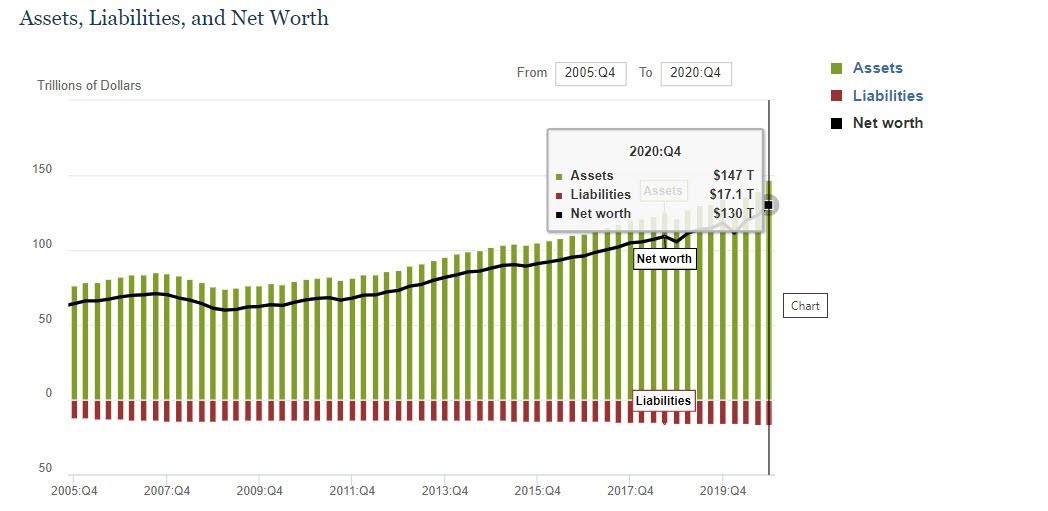
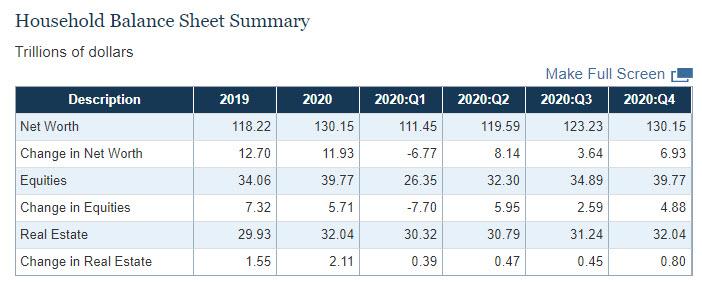
As usual, the biggest swing factor was in the value of market-linked securities: in Q4, the value of directly and indirectly held corporate equities increased by $4.881 trillion due to the continued surge in stock prices (after the record $5.95 trillion increase in Q2) to a record $39.8 trillion, while the value of real estate held by households by a far more modest $800 billion. The high rate of personal saving also contributed to the increase in net worth, while the value of real estate held by households increased modestly.
As a percentage of Disposable Personal Income, total assets also hit a new all-time high of 853% of DPI, while net worth was 754% of disposable income, also a record high.
(Click on image to enlarge)
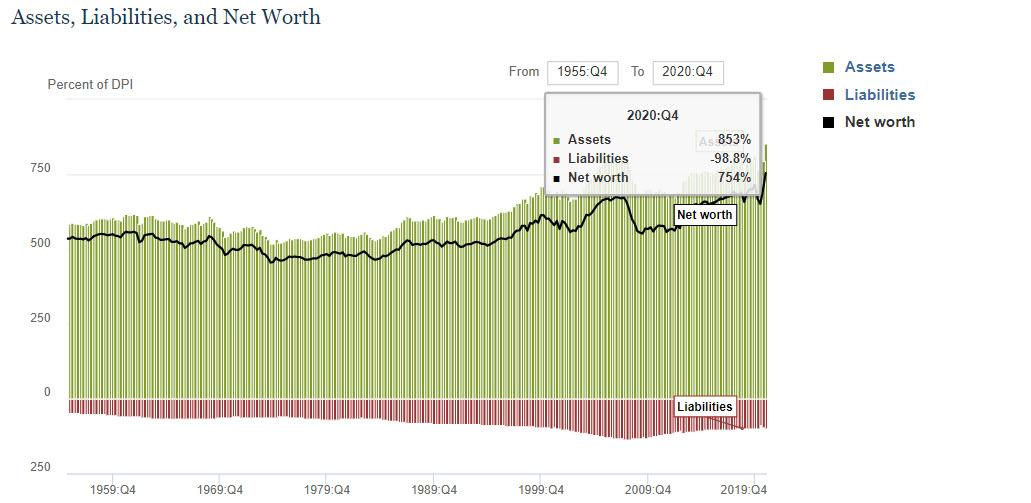
Real estate ($32.0 trillion) and directly and indirectly held corporate equities ($39.8 trillion) were among the largest components of household net worth. Homeowners’ real estate holdings minus the change in mortgage debt rose $654.5 billion (a positive value indicates that the value of real estate is growing at a faster pace than household mortgage debt). Finally, owners’ equity as a percentage of total real estate value rose to 65.87% to a level of $21.103 trillion
(Click on image to enlarge)

On the liabilities side, total credit rose from $16.37 trillion to $16.64 trillion.
(Click on image to enlarge)
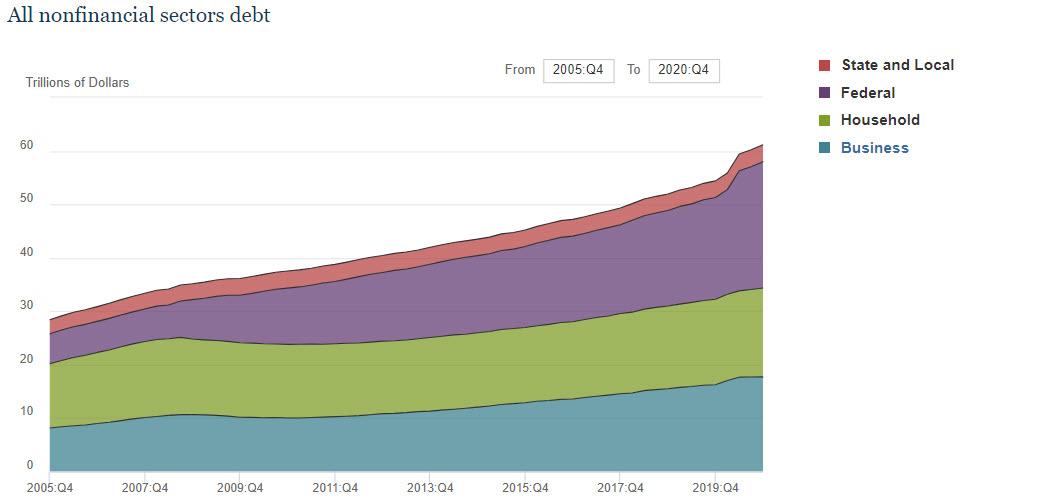
Household debt grew by 6.5% in the fourth quarter of 2020. Home mortgages increased by 5.2%, after growing by 5.7% in the third quarter. Nonmortgage consumer credit increased at a more moderate 2.3% pace, about the same pace as in the third quarter. The increase in consumer credit reflects growth in auto loans and student loans, while credit card balances continued to decline. Alarming growth in margin debt also boosted household debt growth over the second half of 2020.
Nonfinancial business debt edged up at a modest rate of 0.8%, reflecting increases in corporate bonds outstanding and declines in nonmortgage depository loans. Federal debt rose 10.9%. State and local debt increased 1.7%.
As GDP continued to recover in the third quarter, the ratio of nonfinancial debt to GDP moved down further. In the second quarter, the ratio had spiked, driven by the drop in GDP and the expansion in federal debt related to the fiscal stimulus.
(Click on image to enlarge)

Looking at the various components of nonfinancial business debt, nonmortgage depository loans to nonfinancial business declined $118 billion, reflecting forgiveness of loans extended under the Paycheck Protection Program, or PPP, and weak loan origination. Nonmortgage depository loans had expanded notably over the first half of 2020 as firms tapped their lines of credit at banks and PPP loans were disbursed. Partly offsetting the decline in nonmortgage bank loans, corporate bonds continued to increase, although at a slower pace than in the second and third quarters.
(Click on image to enlarge)
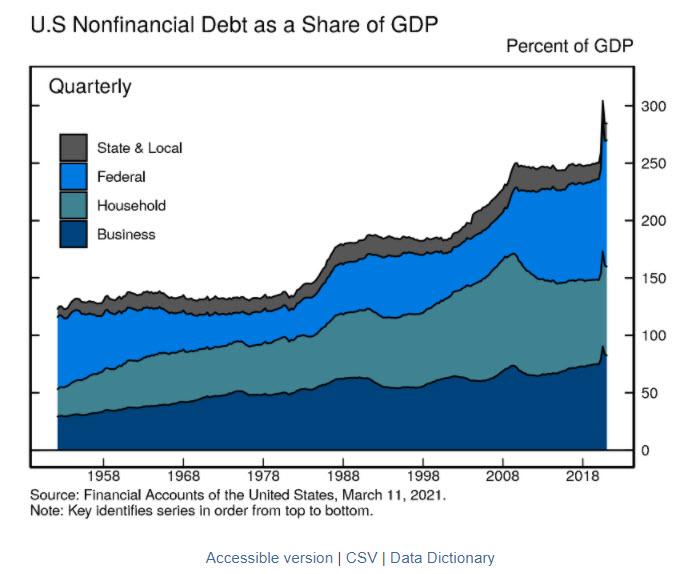
Overall, outstanding nonfinancial corporate debt was $11.1 trillion. Corporate bonds, at roughly $6.5 trillion, accounted for 59% of the total. Nonmortgage depository loans were about $1.1 trillion. Other types of debt include loans from nonbank institutions, loans from the federal government, and commercial paper.
The nonfinancial noncorporate business sector consists mostly of smaller businesses, which are typically not incorporated. The nonfinancial noncorporate business debt was $6.6 trillion, of which $4.6 trillion were mortgage loans and $1.6 trillion were nonmortgage depository loans.
(Click on image to enlarge)

The bottom line is that (especially if one ignores the debt - which clearly will be monetized or hyperinflated by the Fed before it all comes crashing down) the US economy has never been stronger. And while it would be great news if wealth across all of America had indeed risen as much as the Fed claims, the reality is that there is a big catch: as shown previously, virtually all of the net worth, and associated increase thereof, has only benefited a handful of the wealthiest Americans.
According to a record Census Bureau report, over the past decade, during an economic expansion that benefited most Americans, the richest made out the best. In fact, the CB found that the top 5% of households - those making $451,122 on average last year - have seen their inflation-adjusted incomes jump 28% since 2009.
The gain - which helped push inequality to the widest in decades - compares with a mere 11% rise for the bottom 20%, whose income rose to about $15,290 from roughly $13,800 a decade ago. Those in the middle groups - who made between $40,600 and $111,100 last year - saw their incomes rise between 16% to 18%, the data show.
(Click on image to enlarge)

A separate breakdown of the change in net worth, as also discussed previously, one which looks at median net worth by age of head (of household) shows that the oldest Americans - those 65 and older - have seen gains in their net worth by over 60%, while everyone else is either flat or down!
(Click on image to enlarge)

This underscores just how endemic poverty is in America, even in times of economic expansion. While incomes have increased, so has the cost of living, with consumer prices rising 20% since 2009. Meanwhile, while financial assets - those which have grown the most in the past decade - soaring thanks to the Fed's generous monetary policy and benefiting those who own financial assets, this turns out to be a tiny sliver of the population. In the CBO's latest, if somewhat dated, Trends in Family Wealth analysis published in 2016, the budget office showed a breakdown of the net worth chart by wealth group, which sadly shows how the "average" American wealth is anything but, and in reality most of that $100 trillion belongs to just 10% of the US population. The distribution has only gotten worse since then.
(Click on image to enlarge)

Here is how the CBO recently explained the wealth is distributed:
- In 2013, families in the top 10 percent of the wealth distribution held 76 percent of all family wealth, families in the 51st to the 90th percentiles held 23 percent, and those in the bottom half of the distribution held 1 percent.
- Average wealth was about $4 million for families in the top 10 percent of the wealth distribution, $316,000 for families in the 51st to 90th percentiles, and $36,000 for families in the 26th to 50th percentiles. On average, families at or below the 25th percentile were $13,000 in debt.
In other words, roughly 75% of the $7.6 trillion increase in assets went to benefit just 10% of the population, who also account for roughly 76% of America's financial net worth. It also means that just 10% of the US population is worth roughly $90 trillion, while half of the US population was virtually no wealth, and if anything it is deeply in debt.
(Click on image to enlarge)

Even worse, when looking at how wealth distribution changed since the 1980s, an even more dire picture emerges: family wealth grew at significantly different rates for different segments of the U.S. population. In 2013, for example:The wealth of families at the 90th percentile of the distribution was 54% greater than the wealth at the 90th percentile in 1989, after adjusting for changes in prices.
- The wealth of those at the median was 4 percent greater than the wealth of their counterparts in 1989.
- The wealth of families at the 25th percentile was 6 percent less than that of their counterparts in 1989.
- As the chart below shows, nobody has experienced the same cumulative growth in after-tax income as the "Top 1%"
(Click on image to enlarge)

The above is particularly topical at a time when both parties is trying to take credit for any fledgling US recovery. Here, while previously Democrats, and now Republicans tout the US "income recovery" they may have forgotten about half of America, but one entity remembers well: loan collectors. As the chart below shows, America's poor families have never been more in debt.
The share of families in debt (those whose total debt exceeded their total assets) remained almost unchanged between 1989 and 2007 and then increased by 50 percent between 2007 and 2013. In 2013, those families were more in debt than their counterparts had been either in 1989 or in 2007. For instance, 8 percent of families were in debt in 2007 and, on average, their debt exceeded their assets by $20,000. By 2013, in the aftermath of the recession of 2007 to 2009, 12 percent of families were in debt and, on average, their debt exceeded their assets by $32,000.
The increase in average indebtedness between 2007 and 2013 for families in debt was mainly the result of falling home equity and rising student loan balances. In 2007, 3 percent of families in debt had negative home equity: They owed, on average, $16,000 more than their homes were worth. In 2013, that share was 19 percent of families in debt, and they owed, on average, $45,000 more than their homes were worth. The share of families in debt that had outstanding student debt rose from 56 percent in 2007 to 64 percent in 2013, and the average amount of their loan balances increased from $29,000 to $41,000.
(Click on image to enlarge)
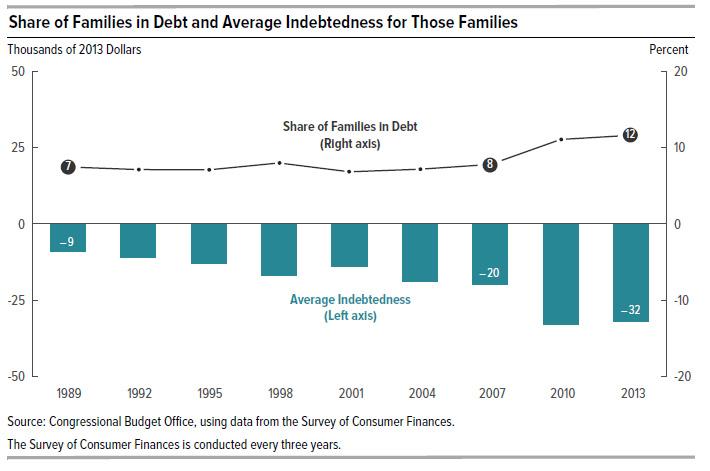
And there - as we say quarter after quarter- is your "recovery": the wealthy have never been wealthier, while half of America, some 50% of households, own just 1% of the country's wealth, down from 3% in 1989. And finally, America's poor have never been more in debt.
Disclaimer: Copyright ©2009-2021 ZeroHedge.com/ABC Media, LTD; All Rights Reserved. Zero Hedge is intended for Mature Audiences. Familiarize yourself with our legal and use policies every time ...
more


